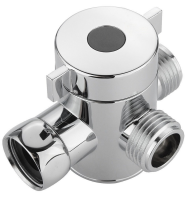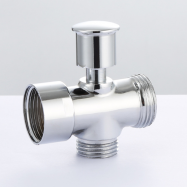How to Choose the Right Angle Valve for Your Fixtures
An angle valve is a small but critical plumbing component that controls water flow to fixtures like toilets, sinks, and showers. Installed at the corner where the water pipe meets the fixture, it allows you to shut off water to a specific fixture without turning off the main water supply—essential for repairs, maintenance, or emergencies. Choosing the right angle valve ensures reliable performance, prevents leaks, and fits your plumbing setup. This guide explains how to select the right angle valve for your fixtures, covering key factors like material, size, type, and compatibility.
Understand the Role of an Angle Valve
Before choosing an angle valve, it’s important to understand its function. An angle valve connects the main water supply pipe (usually coming from the wall) to the flexible hose that feeds water to a fixture, such as a toilet, bathroom sink, or kitchen faucet. Its angled design (typically 90 degrees) allows it to fit in tight spaces behind fixtures, where a straight valve would not work.
The primary role of an angle valve is to control water flow:
- On/Off Control: Turning the valve handle shuts off water to the fixture, making repairs (like fixing a leaky faucet) or replacing the fixture easy without disrupting water to the entire house.
- Pressure Regulation: Some angle valves help control water pressure, preventing damage to sensitive fixtures like bidets or water heaters.
- Flow Restriction: Certain models limit water flow to reduce waste, though this is less common in standard angle valves.

Every fixture that connects to the water supply (toilets, sinks, showers, dishwashers) should have its own angle valve. Choosing the right one ensures each fixture operates safely and efficiently.
Consider the Material for Durability and Corrosion Resistance
The material of an angle valve determines its durability, resistance to corrosion, and lifespan—critical factors in wet, humid plumbing environments.
- Brass: The most popular material for angle valves, brass is strong, corrosion-resistant, and compatible with both hot and cold water. It withstands high pressure and temperature changes, making it suitable for all fixtures. Brass angle valves often have a chrome or nickel plating for a polished look and extra protection. They are slightly more expensive than other materials but last 10–20 years with proper use.
- Stainless Steel: A durable, rust-resistant option, stainless steel angle valves work well in areas with hard water (high mineral content), which can corrode other metals. They are strong, easy to clean, and compatible with most plumbing systems. Stainless steel is a good alternative to brass, though it may be pricier.
- Plastic: Affordable but less durable, plastic angle valves are made from materials like PVC or PEX. They work for low-pressure, cold-water applications (like outdoor faucets) but are not recommended for hot water or high-pressure indoor fixtures. Plastic can crack over time, especially with temperature fluctuations, leading to leaks.
- Chrome-Plated Zinc: A budget option, zinc angle valves with chrome plating are cheaper than brass but less durable. The plating can chip, exposing the zinc to water and causing corrosion. They are best for temporary use or low-use fixtures, as they may need replacement within 5–7 years.
For most indoor fixtures, brass or stainless steel angle valves are the best choices, offering long-term reliability and resistance to corrosion.
Check Size and Connection Type for Compatibility
Angle valves come in different sizes and connection types, and choosing the right one ensures a secure fit with your plumbing pipes and fixture hoses.
- Inlet and Outlet Sizes: The inlet (connects to the main water pipe) and outlet (connects to the fixture hose) sizes must match your plumbing. Common sizes are 1/2 inch for the inlet (standard for most household water pipes) and 3/8 inch or 1/2 inch for the outlet (depends on the fixture). Toilet angle valves often use a 3/8-inch outlet, while sink or shower valves may use 1/2 inch. Check your existing valve or fixture manual to confirm sizes.
-
Connection Types: Angle valves use different connection methods to attach to pipes and hoses:
- Compression Fittings: The most common type, compression angle valves use a nut and ring to seal against the pipe, requiring no soldering. They are easy to install and work with copper, PEX, or plastic pipes.
- Threaded Fittings: These angle valves have male or female threads that screw directly onto threaded pipes. They are secure but require Teflon tape or pipe dope to prevent leaks.
- Sweat Fittings: Also called soldered fittings, these require heating and soldering to attach to copper pipes. They create a permanent, leak-proof seal but require plumbing skills to install.
Choose an angle valve with connections that match your pipes (copper, PEX, etc.) and fixture hoses to avoid leaks or the need for adapters.
Select the Right Type of Angle Valve for Your Fixture
Angle valves are designed for specific fixtures, with features tailored to their needs. Matching the valve type to the fixture ensures optimal performance.
- Toilet Angle Valve: Designed for low-pressure, cold-water supply to toilets. They often have a 3/8-inch outlet and a slow-closure feature to prevent water hammer (loud banging from sudden pressure changes). Look for a compact design to fit behind the toilet tank.
- Sink Angle Valve: Used for both hot and cold water to bathroom or kitchen sinks. They handle higher pressure than toilet valves and may have a 1/2-inch outlet to match sink faucet hoses. Some models have a quarter-turn handle for quick on/off control.
- Shower/Bathtub Angle Valve: These angle valves control hot and cold water to showers or tubs, requiring higher pressure tolerance. They are often part of a larger valve system but may be used as individual shut-off valves for each supply line.
- Appliance Angle Valve: Designed for appliances like dishwashers or washing machines, these valves handle high pressure and may include a built-in pressure regulator. They often have a 3/4-inch inlet to match appliance supply lines.
Choosing a valve designed for your specific fixture ensures it can handle the water pressure, temperature, and flow rate required.
Evaluate Handle Type and Operation
The handle of an angle valve affects how easy it is to use, especially in tight spaces behind fixtures.
- Quarter-Turn Handle: The most user-friendly option, quarter-turn angle valves open or close with a 90-degree turn of the handle (from off to on). They are quick to operate and less likely to stick over time, making them ideal for frequent use. Handles are often lever-style, which is easier to grip than knobs.
- Multi-Turn Handle: These require several turns to open or close, using a stem that raises and lowers. They are more common in older homes and may be slower to operate but are reliable. However, the stem can wear out over time, leading to leaks.
- Key-Operated Handle: A security feature, key-operated angle valves require a special key to turn, preventing unauthorized use (useful in commercial settings or shared spaces). They are less common in residential homes but add safety.
Quarter-turn handles are preferred for most residential angle valves due to their ease of use and durability. Ensure the handle is easy to reach behind the fixture—some valves have extended handles for better access.
Check for Safety and Certification
High-quality angle valves meet safety standards to ensure they are leak-proof and reliable. Look for certifications to confirm quality.
- NSF/ANSI Certification: Valves certified by NSF International or ANSI meet standards for material safety, ensuring they do not leach harmful substances into drinking water. This is especially important for angle valves supplying water to sinks or appliances used for food preparation.
- Pressure Rating: Check the valve’s pressure rating (usually marked in psi) to ensure it can handle your home’s water pressure. Most residential systems have pressure between 40–80 psi, so choose an angle valve rated for at least 100 psi to be safe.
- Lead-Free Compliance: In many regions, angle valves must be lead-free to protect drinking water. Look for valves labeled “lead-free” (contains less than 0.25% lead) to meet safety regulations.
Certified angle valves are less likely to fail, reducing the risk of leaks and water damage.
Installation and Maintenance Considerations
Choosing an angle valve that fits your installation skills and maintenance needs ensures long-term performance.
- DIY vs. Professional Installation: Compression or threaded angle valves are DIY-friendly, requiring basic tools like a wrench and Teflon tape. Sweat (soldered) valves require plumbing experience, so hire a professional if you’re not comfortable soldering.
- Accessibility: Install the angle valve in a location that’s easy to reach for turning on/off or maintenance. Avoid hiding it behind large fixtures where it’s hard to access in an emergency.
- Maintenance: Angle valves require minimal maintenance, but periodic checks for leaks (around connections) and lubrication (for sticky handles) help extend their lifespan. Choose valves with replaceable parts (like stems or washers) to avoid replacing the entire valve if a component wears out.
Selecting an easy-to-install and maintain angle valve saves time and ensures you can address issues quickly.
FAQ
How do I know if my angle valve needs replacement?
Signs include leaks around the valve, difficulty turning the handle, rust or corrosion, or reduced water flow. If the valve no longer shuts off water completely, it’s time to replace it.
Can I use the same angle valve for hot and cold water?
Yes, but ensure the valve is rated for hot water (brass or stainless steel). Plastic valves are not suitable for hot water, as heat can cause them to warp.
What size angle valve do I need for a toilet?
Most toilets use a 1/2-inch inlet (to connect to the main pipe) and a 3/8-inch outlet (to connect to the toilet hose). Check your toilet’s manual to confirm.
Are quarter-turn angle valves better than multi-turn?
Quarter-turn valves are easier to operate and less likely to stick, making them better for most homes. Multi-turn valves are reliable but slower to use.
How long do angle valves last?
Brass or stainless steel angle valves can last 10–20 years with proper use. Plastic or zinc valves may need replacement in 5–7 years.
Table of Contents
- Understand the Role of an Angle Valve
- Consider the Material for Durability and Corrosion Resistance
- Check Size and Connection Type for Compatibility
- Select the Right Type of Angle Valve for Your Fixture
- Evaluate Handle Type and Operation
- Check for Safety and Certification
- Installation and Maintenance Considerations
- FAQ


